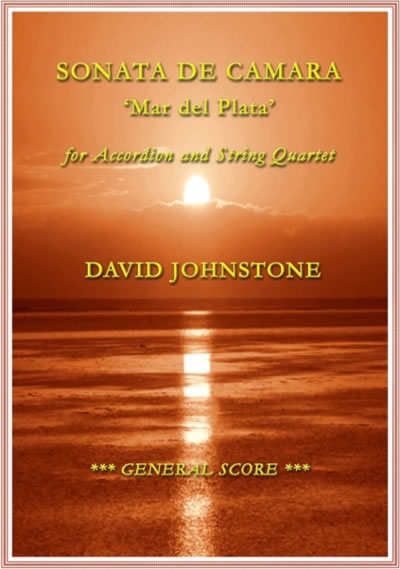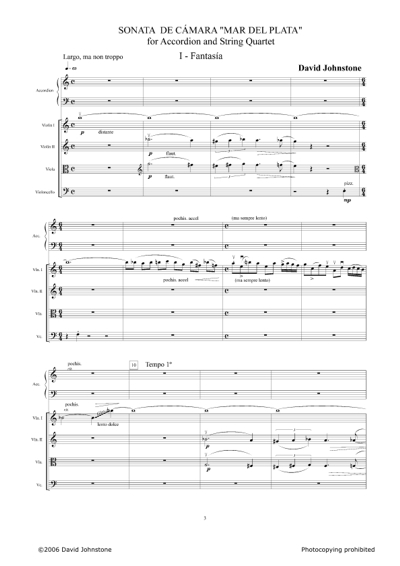The Sonata de Camara ‘Mar del Plata’ is not intended to be specifically a ‘tango’ work although one can appreciate many influences of this style, especially in the rhythmical aspects. This work for Accordion and String Quartet was born out of the respect and ‘well-feeling’ towards Astor Piazzolla, the ‘father figure’ of modern Argentinian music, who was born in the city of Mar del Plata in 1921.
The sonata is structured in four movements, which at the same time form two large entities comprising two linked, and almost joined, movements each one. Various themes are treated cyclically (motives of one movement appear in transformations in other movements) to achieve more solidity and unity to the work.
The first movement ‘Fantasia’ (largo, ma non troppo) is the most abstract movement of the four, incorporating Cadenzas for the accordionist and agreeable dissonances in the strings. Its function is that of a long introduction which launches into the following movement with the briefest of a pause.
The second movement ‘Allegro de Concert’ (allegro moderato, espresivo e triste) is written in a very free type of ‘Sonata form’ where in some way the ‘tango’ music is mixed with ‘new-age’ without losing at the same time a true classical feeling. The re-exposition quickly develops towards a highly powered climax towards the end, then gradually coming to rest on some deliberate static harmonies which well prepare the ambience for the following movement.
The third movement takes us back into the history of music – an authentic ‘Habanera’ (tempo di habanera, tranquilo) full of sweetness, sensuality and generally introspective. There is an especial melodic role given to the violinists and viola, whilst the violoncello gentling portrays the characteristic habanera throbbing pulsations.
When the solo accordion passages at the beginning of the fourth movement are reached – ‘Vigoroso’ (introduction – allegro) – there is an obvious return to modernity in what is to become a very rhythmic piece with many interesting outwardly projected passages (and not only for the accordion but for all string players), with elements of humour, musical conversations and a passionate conclusion.
The work was written bearing in mind the positive influences on the composer of the important Spanish solo accordionist Francisco Javier López Jaso. It was initially conceived in this form for the combination of string quartet and accordion – and dedicated to the Spanish group ‘Neofusion’ in which López Jaso plays; however it is equally well programmable as a Concerto work with full string orchestra (in this case consult with ‘Creighton’s Collection’ for the work Concierto de Camara ‘Mar del Plata’ for an easy-to-read conductor score and full orchestral string parts including double-bass).The total performance time is about 22 – 23 minutes, making it a sensible choice as a novelty in string quartet programmes, and is of course particularly beckoning for those accordion soloists looking for an unusual but beautiful instrumental combination.
clip from 2 movement 'Allegro de Concert'
clip from 3 movement 'Habanera'
clip from 4 movement 'Vigoroso'

Score
